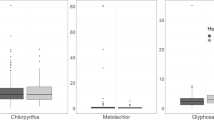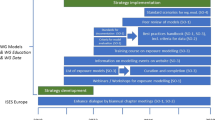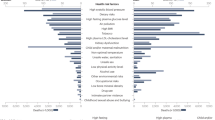Abstract
The use of cumulative exposure, the product of intensity and duration, has enjoyed great popularity in epidemiology of chronic diseases despite numerous known caveats in its interpretation. We briefly review the history of use of cumulative exposure in epidemiology and propose an alternative method for relating time-integrated exposures to health risks. We argue, as others before us have, that cumulative exposure metrics obscures the interplay of exposure intensity and duration. We propose to use a computationally simple alternative in which duration and intensity of exposure are modelled as a main effect and their interaction, cumulative exposure, only be added if there is evidence of deviation from this additive model. We also consider the Lubin–Caporaso model of interplay of exposure intensity and duration. The impact of measurement error in intensity on model selection was also examined. The value of this conceptualization is demonstrated using a simulation study and further illustrated in the context of respiratory health and occupational exposure to latex dust. We demonstrate why cumulative exposure has been so popular because the cumulative exposure metric per se gives a robust answer to the existence of an association, regardless of the underlying true mechanism of disease. Treating cumulative exposure as the interaction of main effects of exposure duration and intensity enables epidemiologists to derive more information about mechanism of disease then fitting cumulative exposure metric by itself, and without the need to collect additional data. We propose that the practice of fitting duration, intensity and cumulative exposure separately to epidemiologic data should lead to conceptualization of cumulative exposure as interaction of main effects of duration and intensity of exposure.
This is a preview of subscription content, access via your institution
Access options
Subscribe to this journal
Receive 6 print issues and online access
$259.00 per year
only $43.17 per issue
Buy this article
- Purchase on Springer Link
- Instant access to full article PDF
Prices may be subject to local taxes which are calculated during checkout


Similar content being viewed by others
References
Bradford-Hill A . The environment and disease: association or causation? Proc Royal Soc Med 1966; 58: 295.
Jenicek M . Epidemiology, evidenced-based medicine, and evidence-based public health. J Epidemiol 1997; 7: 187–197.
Victoria CG, Habicht JP, Bryce J . Evidence-based public health: moving beyond randomized trials. Am J Public Health 2004; 94: 400–405.
Smith TJ, Kriebel D . Applications of exposure assessment in epidemiology. A Biologic Approach to Environmental Assessment and Epidemiology. Oxford University Press: New York, NY, USA, 2010, p 426.
Kriebel D, Checkoway H, Pearce N . Exposure and dose modelling in occupational epidemiology. Occup Environ Med 2007; 64: 492–498.
Checkoway H, Rice CH . Time-weighted averages, peaks, and other indices of exposure in occupational epidemiology. Am J Ind Med 1992; 21: 25–33.
Checkoway H, Pearce N, Kriebel D . Exposure and dose modeling. Research Methods in Occupational Epidemiology. 2nd edn, Chapter 10, Oxford University Press: New York, NY, USA, 2004, p 386.
White E, Armstrong BK, Saracci R . Exposure measurement. Principles of Exposure Measurement in Epidemiology, 2nd edn, Oxford University Press: Oxford, 2008, pp 1–36.
Thomas D . Models for exposure-time-response relationships with applications to cancer epidemiology. Annu Rev Public Health 1988; 9: 31.
Blair A, Stewart PA . Do quantitative exposure assessments improve risk estimates in occupational studies of cancer? Am J Ind Med 1992; 21: 53–63.
McDonald JC, McDonald AD, Hughes JM, Rando RJ, Weill H . Mortality from lung and kidney disease in a cohort of North American industrial sand workers: an update. Ann Occup Hyg 2005; 49: 6.
Ruidavets JB, Ducimetiere P, Evans A, Montaye M, Haas B, Bingham A et al. Patterns of alcohol consumption and ischaemic heart disease in culturally divergent countries: the Prospective Epidemiological Study of Myocardial Infarction (PRIME). BMJ 2010; 341: c6077.
Smith TJ . Occupational exposure and dose over time: limitations of cumulative exposure. Am J Ind Med 1992; 21: 35–51.
Henneberger PK, Cumro D, Deubner DD, Kent MS, McCawley M, Kreiss K . Beryllium sensitization and disease among long-term and short-term workers in a beryllium ceramics plant. Int Arch Occup Environ Health 2001; 74: 167–176.
Miedinger D, Malo JL, Ghezzo H, L'Archeveque J, Zunzunegui MV . Factors influencing duration of exposure with symptoms and costs of occupational asthma. Eur Respir J 2010; 36: 728–734.
Platts-Mills TA, Woodfolk JA, Erwin EA, Aalberse R . Mechanisms of tolerance to inhalant allergens: the relevance of a modified Th2 response to allergens from domestic animals. Springer Semin Immunopathol 2004; 25: 271–279.
Riedl MA, Diaz-Sanchez D, Linn WS, Gong H Jr, Clark KW, Effros RM et al. Allergic inflammation in the human lower respiratory tract affected by exposure to diesel exhaust. Res Rep Health Eff Inst 2012; 165: 5–43.
Lubin JH, Caporaso NE . Misunderstandings in the misconception on the use of pack-years in analysis of smoking. Br J Cancer 2013; 108: 1218–1220.
Peto J . That the effects of smoking should be measured in pack-years: misconceptions 4. Br J Cancer 2012; 107: 406–407.
Stayner L, Steenland K, Dosemeci M, Hertz-Picciotto I . Attenuation of exposure-response curves in occupational cohort studies at high exposure levels. Scand J Work Environ Health 2003; 29: 317–324.
Wu C, Hamada M . Experiments: Planning, Analysis, and Optimization, 2nd edn, John Wiley & Sons Inc: Hoboken, New Jersey, 2009.
Lubin JH, Caporaso NE . Cigarette smoking and lung cancer: modeling total exposure and intensity. Cancer Epidemiol Biomarkers Prev 2006; 15: 517–523.
R Development Core Team. R: A Language and Environment for Statistical Computing. R Foundation for Statistical Computing: Vienna, 2008; ISBN 3-900051-07-0.
Sanguanchaiyakrit N . Occupational exposure and ill-health among workers during latex glove manufacturing in Thailand. PhD thesis, The University of Manchester: Manchester, UK, 2013.
Sanguanchaiyakrit N, Povey AC, de Vocht F . Personal exposure to inhalable dust and the specific latex-aero-allergen, Hev b6.02, in latex manufacturing in Thailand. Ann Occup Hyg 2014; 58: 542–550.
Farzaneh P, Hassan ZM, Pourpak Z, Hoseini AZ, Hogan SP . A latex-induced allergic airway inflammation model in mice. Basic Clin Pharmacol Toxicol 2006; 99: 405–411.
Boffetta P, Burstyn I, Partanen T, Kromhout H, Svane O, Langård S et al. Cancer mortality among European asphalt workers: an international epidemiological study. II. Exposure to bitumen fume and other agents. Am J Ind Med 2003; 43: 9.
Olsson A, Kromhout H, Agostini M, Hansen J, Lassen CF, Johansen C et al. A case-control study of lung cancer nested in a cohort of European asphalt workers. Environ Health Perspect 2010; 118: 1418–1424.
Seixas N, Robins T, Becker M . A novel approach to the characterization of cumulative exposure for the study of chronic occupational disease. Am J Epidemiol 1993; 137: 8.
Lubin JH, Purdue M, Kelsey K, Zhang ZF, Winn D, Wei Q et al. Total exposure and exposure rate effects for alcohol and smoking and risk of head and neck cancer: a pooled analysis of case-control studies. Am J Epidemiol 2009; 170: 937–947.
Bertoia ML, Triche EW, Michaud DS, Baylin A, Hogan JW, Neuhouser ML et al. Long-term alcohol and caffeine intake and risk of sudden cardiac death in women. Am J Clin Nutr 2013; 97: 1356–1363.
Gustafson P, Kazi AM, Levy AR . Extending logistic regression to model diffuse interactions. Stat Med 2005; 24: 2089–2104.
Liu J, Gustafson P . Average effects and omitted interactions in linear regression models. Int Stat Rev 2008; 76: 419–432.
Smith TJ, Kriebel D . Disease process models. A Biologic Approach to Environmental Assessment and Epidemiology. Oxford University Press: New York, 2010, p 426.
Burstyn I, Kim H, Yasui Y, Cherry N . The virtues of a deliberately misspecified disease model in demonstrating a gene-environment interaction. Occup Environ Med 2009; 66: 6.
Gustafson P, Burstyn I . Bayesian inference of gene-environment interaction from incomplete data: what happens when information on environment is disjoint from data on gene and disease? Stat Med 2011; 30: 12.
Luo H, Burstyn I, Gustafson P . Costs and benefits of environmental data in investigations of gene-disease associations. Epidemiology 2013; 24: 562–568.
Acknowledgements
The data on respiratory health and exposure to inhalable aerosol in the Thai latex glove industry was part of a PhD project (by NS) sponsored by the Royal Thai Government.
Author information
Authors and Affiliations
Corresponding author
Ethics declarations
Competing interests
The authors declare no conflict of interest.
Additional information
Supplementary Information accompanies the paper on the Journal of Exposure Science and Environmental Epidemiology website
Supplementary information
Rights and permissions
About this article
Cite this article
de Vocht, F., Burstyn, I. & Sanguanchaiyakrit, N. Rethinking cumulative exposure in epidemiology, again. J Expo Sci Environ Epidemiol 25, 467–473 (2015). https://doi.org/10.1038/jes.2014.58
Received:
Revised:
Accepted:
Published:
Issue Date:
DOI: https://doi.org/10.1038/jes.2014.58
Keywords
This article is cited by
-
Understanding Training Load as Exposure and Dose
Sports Medicine (2023)
-
Impact of time-varying cumulative bevacizumab exposures on survival: re-analysis of data from randomized clinical trial in patients with metastatic colo-rectal cancer
BMC Medical Research Methodology (2021)
-
Lung function and paper dust exposure among workers in a soft tissue paper mill
International Archives of Occupational and Environmental Health (2020)
-
Cumulative alcohol consumption and stroke risk in men
Journal of Neurology (2019)
-
A new approach for investigation of person–environment interaction effects in research involving health outcomes
European Journal of Ageing (2019)



